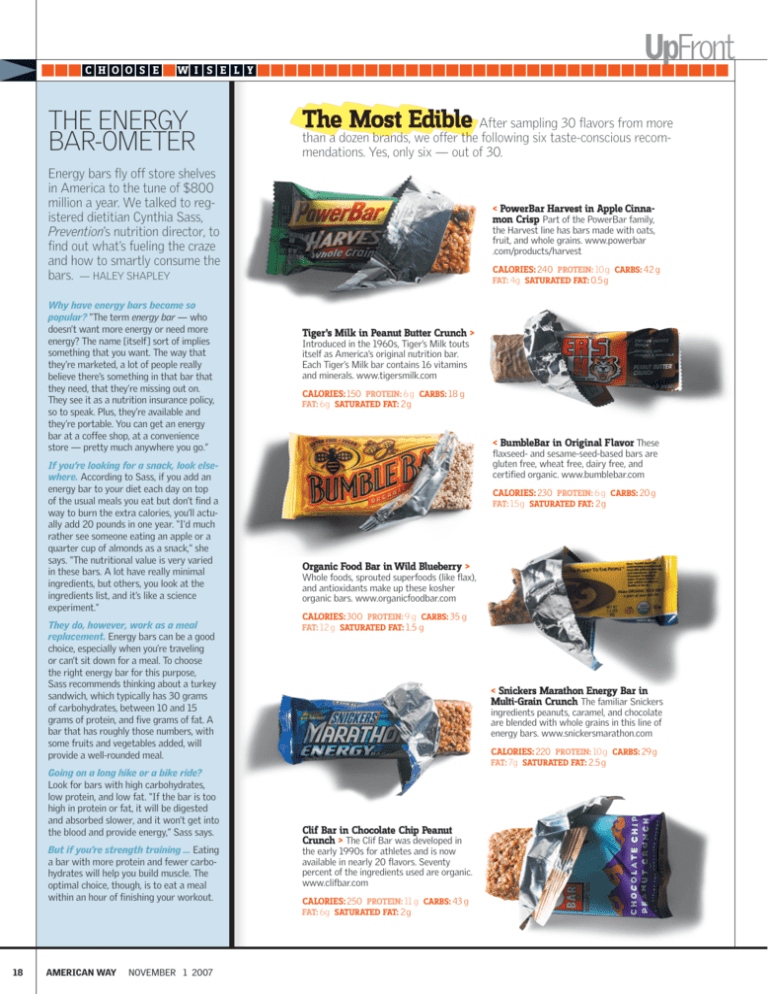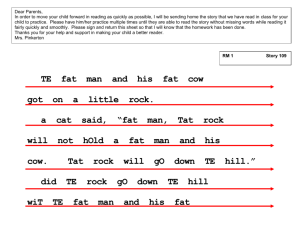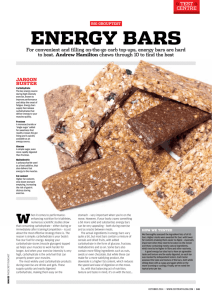THE EnErgY BAr
advertisement

C H O O S E W I S E L Y The Energy Bar-Ometer The Most Edible After sampling 30 flavors from more than a dozen brands, we offer the following six taste-conscious recommendations. Yes, only six — out of 30. Energy bars fly off store shelves in America to the tune of $800 million a year. We talked to registered dietitian Cynthia Sass, Prevention’s nutrition director, to find out what’s fueling the craze and how to smartly consume the bars. — Haley Shapley Why have energy bars become so popular? “The term energy bar — who doesn’t want more energy or need more energy? The name [itself] sort of implies something that you want. The way that they’re marketed, a lot of people really believe there’s something in that bar that they need, that they’re missing out on. They see it as a nutrition insurance policy, so to speak. Plus, they’re available and they’re portable. You can get an energy bar at a coffee shop, at a convenience store — pretty much anywhere you go.” If you’re looking for a snack, look elsewhere. According to Sass, if you add an energy bar to your diet each day on top of the usual meals you eat but don’t find a way to burn the extra calories, you’ll actually add 20 pounds in one year. “I’d much rather see someone eating an apple or a quarter cup of almonds as a snack,” she says. “The nutritional value is very varied in these bars. A lot have really minimal ingredients, but others, you look at the ingredients list, and it’s like a science experiment.” They do, however, work as a meal replacement. Energy bars can be a good choice, especially when you’re traveling or can’t sit down for a meal. To choose the right energy bar for this purpose, Sass recommends thinking about a turkey sandwich, which typically has 30 grams of carbohydrates, between 10 and 15 grams of protein, and five grams of fat. A bar that has roughly those numbers, with some fruits and vegetables added, will provide a well-rounded meal. Going on a long hike or a bike ride? Look for bars with high carbohydrates, low protein, and low fat. “If the bar is too high in protein or fat, it will be digested and absorbed slower, and it won’t get into the blood and provide energy,” Sass says. But if you’re strength training … Eating a bar with more protein and fewer carbohydrates will help you build muscle. The optimal choice, though, is to eat a meal within an hour of finishing your workout. 18 AMERICAN WAY NOVEMBER 1 2007 < PowerBar Harvest in Apple Cinnamon Crisp Part of the PowerBar family, the Harvest line has bars made with oats, fruit, and whole grains. www.powerbar .com/products/harvest Calories: 240 Protein: 10 g Carbs: 42 g Fat: 4g Saturated fat: 0.5 g Tiger’s Milk in Peanut Butter Crunch > Introduced in the 1960s, Tiger’s Milk touts itself as America’s original nutrition bar. Each Tiger’s Milk bar contains 16 vitamins and minerals. www.tigersmilk.com Calories: 150 Protein: 6 g Carbs: 18 g Fat: 6g Saturated fat: 2 g < BumbleBar in Original Flavor These flaxseed- and sesame-seed-based bars are gluten free, wheat free, dairy free, and certified organic. www.bumblebar.com Calories: 230 Protein: 6 g Carbs: 20 g Fat: 15g Saturated fat: 2 g Organic Food Bar in Wild Blueberry > Whole foods, sprouted superfoods (like flax), and antioxidants make up these kosher organic bars. www.organicfoodbar.com Calories: 300 Protein: 9 g Carbs: 35 g Fat: 12 g Saturated fat: 1.5 g < Snickers Marathon Energy Bar in Multi-Grain Crunch The familiar Snickers ingredients peanuts, caramel, and chocolate are blended with whole grains in this line of energy bars. www.snickersmarathon.com Calories: 220 Protein: 10 g Carbs: 29 g Fat: 7g Saturated fat: 2.5 g Clif Bar in Chocolate Chip Peanut Crunch > The Clif Bar was developed in the early 1990s for athletes and is now available in nearly 20 flavors. Seventy percent of the ingredients used are organic. www.clifbar.com Calories: 250 Protein: 11 g Carbs: 43 g Fat: 6g Saturated fat: 2 g










